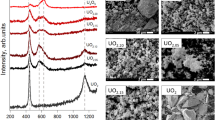Abstract
MOISSAN first directed attention to the pyrophoric properties of metallic uranium. The luminosity shown on shaking a bottle containing metallic uranium is due to the oxidation of small particles of the metal. Uranium is a hard but brittle metal; when pieces of it rub together small particles are knocked off, and if these are neither too small nor too large the friction may be sufficient to heat them above 170° C., at which temperature uranium inflames in air. The presence of smaller particles, which do not inflame visibly in air, is shown by their incandescence in a gas flame lit by the “spark” from the metal. The luminosity obtained by rubbing metallic uranium is not the same class of phenomenon as the luminescence produced by shaking a tube containing uranium nitrate; the latter has been described as tribo luminescence (Wiedemann). If the tube containing metallic uranium is filled with hydrogen no luminosity, is obtained, whereas the luminescence of the uranium nitrate is unabated in such an atmosphere. The sparks obtained from uranium are hot enough to kindle a gas flame or explode a mixture of hydrogen and oxygen; in fact, I have been able to work a petrol engine by igniting the gas charger by means of such sparks. The luminescence of the uranium nitrate crystals, on the other hand, is unaccompanied by any considerable rise in temperature. Pyrophoric properties similar to uranium are shown to a remarkable extent by Welsbach's alloys of rare earth metals and iron.
This is a preview of subscription content, access via your institution
Access options
Subscribe to this journal
Receive 51 print issues and online access
$199.00 per year
only $3.90 per issue
Buy this article
- Purchase on SpringerLink
- Instant access to full article PDF
Prices may be subject to local taxes which are calculated during checkout
Similar content being viewed by others
Author information
Authors and Affiliations
Rights and permissions
About this article
Cite this article
EGERTON, A. Tribo Luminescence of Uranium. Nature 85, 308 (1911). https://doi.org/10.1038/085308a0
Issue date:
DOI: https://doi.org/10.1038/085308a0



